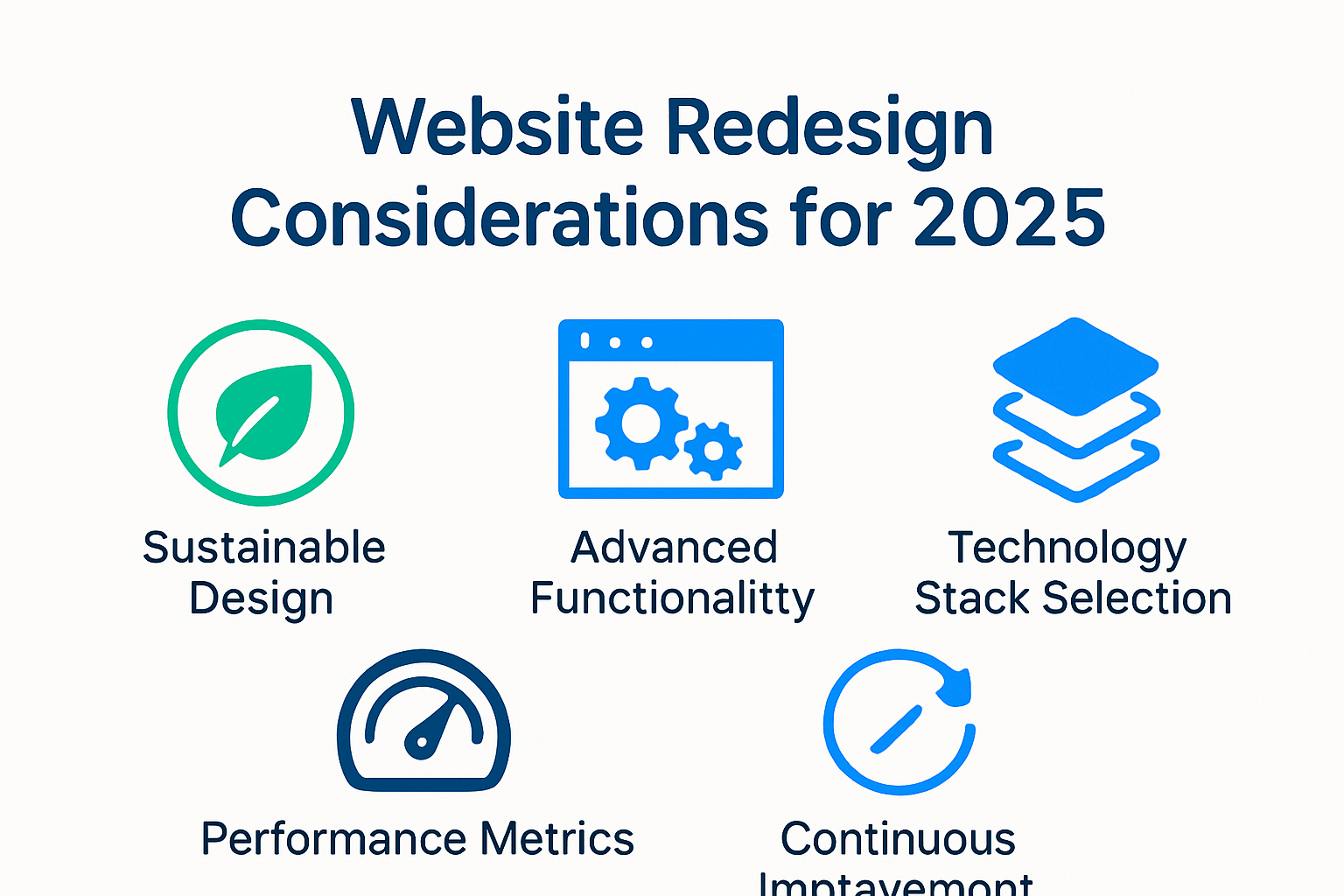Website redesign is not just about getting a fresh look for 2025. More companies are shifting focus because 37% of websites run vulnerable code libraries even after a revamp. You would think a facelift sorts things out but it actually leaves bigger problems if you skip the serious stuff like accessibility, security, and long-term tech choices. Turns out the winning moves are hidden in what most businesses usually overlook.
Table of Contents
- Key Website Redesign Considerations In 2025
- Optimising User Experience And Accessibility
- Choosing The Right Technology Stack
- Measuring Success After Redesign
Quick Summary
| Takeaway | Explanation |
|---|---|
| Prioritise sustainable and inclusive design | Focus on efficient coding and accessibility to minimise environmental impact and enhance user experience. |
| Implement advanced functional integration | Use intelligent personalization and mobile-first design to create dynamic, engaging user interactions. |
| Select a forward-looking technology stack | Choose modular architectures that are secure and adaptable to future trends and business needs. |
| Establish comprehensive performance metrics | Integrate quantitative and qualitative metrics to accurately assess redesign success and user engagement. |
| Adopt a continuous improvement mindset | Treat redesign success as an ongoing process involving regular audits and updates based on user feedback. |

Key Website Redesign Considerations in 2025
Website redesign in 2025 demands a strategic approach that goes far beyond aesthetic updates. Businesses must consider a comprehensive framework that integrates technological innovation, user experience, and strategic digital positioning.
Sustainable and Inclusive Design Principles
Modern web development requires a holistic perspective that prioritises both technological performance and social responsibility. According to the Illinois Department of Innovation & Technology, sustainable web design is no longer optional but a critical requirement. This approach involves creating websites that minimise environmental impact through efficient coding practices and optimised media while ensuring comprehensive accessibility for all users.
To help you review the elements of sustainable and inclusive web design at a glance, here’s a summary table:
| Consideration | Description |
|---|---|
| Efficient Code Architecture | Streamline programming to reduce computational demand and energy use |
| Accessible Design | Apply WCAG 2.2 standards for inclusivity |
| Responsive Media Optimisation | Compress images and videos for quality without excess resource usage |
Key sustainable design considerations include:
- Efficient Code Architecture: Reducing computational demands and energy consumption through streamlined programming
- Accessible Design: Implementing WCAG 2.2 standards to ensure inclusive user experiences
- Responsive Media Optimisation: Compressing images and videos without compromising visual quality

Advanced Functional Integration
The modern website must function as more than a digital brochure. Alliance Innovations emphasises the importance of creating dynamic platforms with purposeful personalization that respects user privacy. This means developing websites that offer intelligent, context-aware interactions while maintaining robust data protection mechanisms.
Strategic functional elements to consider:
- Intelligent Search Capabilities: Implementing advanced search functionalities that understand user intent
- Mobile-First Design: Ensuring seamless experiences across all device types
- Privacy-Conscious Personalization: Delivering tailored experiences without compromising user data security
Technology and Performance Benchmarks
Website redesign in 2025 requires a nuanced understanding of technological ecosystem requirements. Performance is no longer just about speed but about creating integrated, responsive digital experiences that adapt to user needs in real-time. Performance metrics now encompass not just loading times but overall user engagement, accessibility, and technological resilience.
Businesses must evaluate their digital infrastructure through multiple lenses: technical capability, user experience, strategic alignment, and future scalability. This means selecting technologies and design approaches that are not just current but adaptable to emerging digital trends.
Critical performance considerations:
- Cross-Platform Compatibility: Ensuring consistent functionality across browsers and devices
- Load Time Optimization: Implementing advanced caching and content delivery strategies
- Security Infrastructure: Integrating robust protection mechanisms without compromising user experience
Successful website redesign in 2025 is about creating digital platforms that are not just visually appealing but strategically intelligent, environmentally responsible, and user-centric. By embracing these comprehensive considerations, businesses can develop websites that are not merely digital interfaces but powerful strategic assets driving meaningful engagement and growth.
Optimising User Experience and Accessibility
User experience and accessibility have evolved from optional design considerations to fundamental requirements for digital platforms in 2025. Modern websites must deliver seamless, inclusive interactions that accommodate diverse user needs while maintaining intuitive and engaging digital environments.
Comprehensive Accessibility Standards
Accessibility is no longer a peripheral design element but a core requirement for digital platforms. The Web Accessibility Initiative emphasises that inclusive design benefits not just users with disabilities but enhances overall user experience. Research from accessibility experts highlights the critical transition from WCAG 2.0 to WCAG 2.1 standards, which introduce more comprehensive guidelines for digital inclusivity.
For quick comparison of accessibility implementation strategies, see the table below:
| Strategy | Purpose |
|---|---|
| Screen Reader Compatibility | Ensure all content is accessible via assistive tech |
| Keyboard Navigation | Allow full interface operation without mouse use |
| Colour Contrast Compliance | Make content clear for users with visual impairment |
Key accessibility implementation strategies:
- Screen Reader Compatibility: Ensuring all website content can be interpreted by assistive technologies
- Keyboard Navigation: Developing fully navigable interfaces without mouse dependency
- Colour Contrast Compliance: Implementing colour schemes that are perceptible to users with visual impairments
Personalised User Journey Design
User experience in 2025 demands intelligent, adaptive interfaces that respond dynamically to individual user preferences and interaction patterns. This requires sophisticated design approaches that balance personalisation with privacy and user control.
Advanced personalisation techniques:
- Contextual Content Adaptation: Dynamically adjusting website content based on user behaviour and preferences
- Intelligent Recommendation Systems: Providing tailored suggestions without invasive data tracking
- Adaptive Interface Configurations: Allowing users to customise interface elements for optimal comfort
Performance and Interaction Optimization
User experience extends beyond visual design into the realm of performance and interaction quality. Websites must deliver instantaneous responses, smooth transitions, and intuitive navigation that feels almost predictive in its responsiveness.
Critical performance considerations:
- Minimal Load Times: Ensuring sub-second page load speeds across different network conditions
- Smooth Interaction Animations: Creating transitions that feel natural and unobtrusive
- Predictive Interaction Design: Anticipating user needs through intelligent interface elements
The future of digital experiences lies in creating websites that are not just functional but genuinely empathetic. By prioritising accessibility, personalisation, and performance, businesses can develop digital platforms that feel like natural extensions of user intent rather than mechanical interfaces.
Successful user experience design in 2025 requires a holistic approach that considers technological capability, human diversity, and the nuanced ways individuals interact with digital environments. It is about creating digital spaces that welcome, understand, and adapt to every user’s unique needs and preferences.
Choosing the Right Technology Stack
Selecting the appropriate technology stack is a critical strategic decision that can significantly impact a website’s performance, scalability, and long-term sustainability. In 2025, businesses must approach technology selection with a comprehensive, forward-thinking methodology that balances technical capabilities, security considerations, and future adaptability.
Strategic Technology Architecture
Modern web development demands a nuanced approach to technology selection. Urban Insight highlights the growing importance of headless and composable architectures, which provide unprecedented flexibility in website design. These innovative approaches allow businesses to decouple frontend and backend systems, enabling more agile and customizable digital experiences.
Key architectural considerations:
- Modular Component Design: Creating independent, reusable technological modules
- API-Driven Integration: Ensuring seamless communication between different system components
- Scalable Infrastructure: Developing architectures that can easily adapt to changing business needs
Security and Dependency Management
Technology stack selection is not just about features but also about comprehensive security and maintenance. A groundbreaking research study revealed that 37% of websites include at least one library with known vulnerabilities, underscoring the critical importance of robust dependency management.
Here’s a table to summarise essential security and dependency management strategies mentioned:
| Strategy | Action |
|---|---|
| Regular Library Updates | Keep all components at latest versions |
| Vulnerability Assessment | Run security audits regularly |
| Dependency Tracking | Monitor and manage all third-party libraries |
Critical security strategies:
- Regular Library Updates: Maintaining the latest versions of all technological components
- Vulnerability Assessment: Conducting periodic security audits of the entire technology ecosystem
- Dependency Tracking: Implementing robust mechanisms to monitor and manage third-party libraries
Performance and Future-Proofing
Choosing a technology stack in 2025 requires a forward-looking perspective that anticipates emerging technological trends and business requirements. The ideal stack should not only meet current needs but provide a flexible foundation for future innovation.
Performance optimization approaches:
- Microservices Architecture: Breaking down complex systems into manageable, independent services
- Cloud-Native Technologies: Leveraging scalable and distributed computing resources
- Cross-Platform Compatibility: Ensuring consistent performance across multiple devices and platforms
The technology stack is more than a collection of programming languages and frameworks. It represents a strategic ecosystem that directly influences a business’s digital capabilities, user experience, and competitive positioning. Businesses must approach technology selection as a holistic decision that balances technical requirements, security considerations, and long-term strategic objectives.
Successful technology stack selection in 2025 requires a multidimensional approach that goes beyond immediate technical specifications. It demands a deep understanding of business goals, user needs, security requirements, and potential future technological developments. By adopting a strategic, forward-thinking approach to technology selection, businesses can create robust digital platforms that are not just functional today but adaptable for tomorrow’s challenges.
Measuring Success After Redesign
Measuring the success of a website redesign requires a comprehensive, multifaceted approach that goes beyond traditional metrics. In 2025, businesses must develop sophisticated evaluation frameworks that capture both quantitative performance indicators and qualitative user experience insights.
Strategic Performance Benchmarking
Successful website redesign measurement demands a holistic approach to performance evaluation. The University of Oregon emphasises the critical importance of establishing clear benchmarks and conducting rigorous pre-launch and post-launch assessments. This approach allows businesses to understand the tangible impact of their redesign efforts across multiple dimensions.
Key performance metrics to track:
- User Engagement Indicators: Measuring time on site, page interactions, and conversion rates
- Accessibility Compliance: Evaluating how well the new design meets WCAG standards
- Technical Performance: Assessing page load times, mobile responsiveness, and cross-platform functionality
Qualitative User Experience Analysis
Quantitative metrics alone cannot fully capture the success of a website redesign. EDUCAUSE Review highlights the importance of aligning design outcomes with broader organizational objectives. This requires a nuanced approach that combines user feedback, behavioral analysis, and strategic goal alignment.
Advanced evaluation techniques:
- User Feedback Surveys: Collecting detailed insights about user perceptions and experience
- Heatmap and Interaction Tracking: Understanding how users navigate and interact with the new design
- Comparative Analysis: Benchmarking performance against previous website iterations and industry standards
Continuous Improvement Framework
Website redesign success is not a one-time achievement but an ongoing process of refinement and adaptation. Businesses must implement robust monitoring and iteration mechanisms that allow for continuous optimization based on real-world performance and emerging user needs.
Continuous improvement strategies:
- Regular Performance Audits: Conducting periodic comprehensive assessments
- Adaptive Design Iterations: Making data-driven modifications to improve user experience
- Emerging Technology Integration: Identifying and implementing new technologies that enhance website functionality
The true measure of a successful website redesign extends far beyond visual aesthetics or initial performance metrics. It represents a strategic alignment between technological capability, user experience, and organizational objectives. Businesses must approach measurement as a dynamic, ongoing process that views the website as a living digital asset capable of continuous evolution.
Successful measurement requires a holistic perspective that balances technical performance, user satisfaction, and strategic alignment. By developing comprehensive evaluation frameworks that capture both quantitative and qualitative insights, businesses can transform their website redesign from a singular project into a continuous journey of digital innovation and user-centric design.
Frequently Asked Questions
What are the key considerations for a website redesign in 2025?
Successful website redesigns in 2025 should focus on sustainable and inclusive design, advanced functional integration, and careful selection of technology stacks, all while keeping user experience and performance optimization in mind.
How can I ensure my website is accessible to all users?
To ensure accessibility, implement comprehensive accessibility standards such as WCAG 2.2, ensure screen reader compatibility, provide keyboard navigation, and maintain adequate colour contrast for readability.
Why is choosing the right technology stack important for website redesign?
The right technology stack is crucial for optimal website performance, scalability, and security. It allows for flexibility to adapt to future trends and changing business needs while ensuring robust infrastructure.
What metrics should I track to measure the success of a website redesign?
Track user engagement indicators, accessibility compliance, and technical performance metrics such as load times and responsiveness. Combine these with qualitative insights from user feedback to gain a comprehensive view of success.
Unlock Website Redesign That Delivers Real Results
Are you concerned that simply giving your website a facelift might leave you vulnerable to security threats or miss out on meaningful user engagement? Many businesses face this challenge, as covered in our article on top website redesign considerations for 2025. If you want more than just a trendy look, it’s vital your next redesign prioritises inclusive design, robust security, and future-proof technology stacks. These are not just industry buzzwords—they are essential for keeping your business competitive and compliant.
Invest in a digital transformation that is built for the future. At Cloudfusion, our team helps businesses like yours with custom web design, secure development, and full-scale digital solutions that meet every standard discussed in the latest industry research. Ready to make your redesign count? Get a free consultation and tailored quotation by visiting Web Design and Development Quotation. Take your next step toward a powerful online presence today at Cloudfusion.








